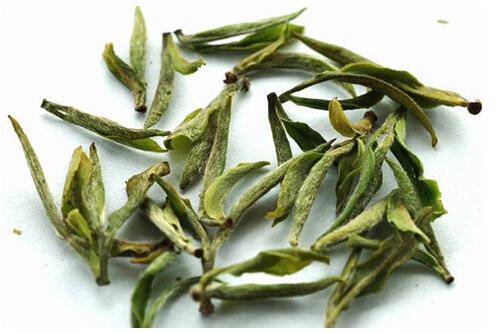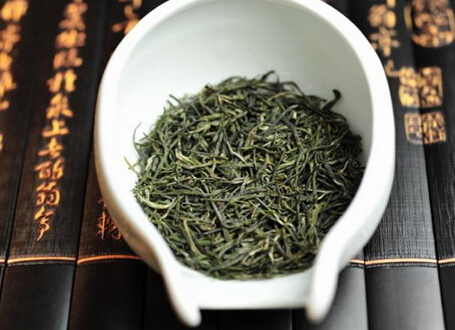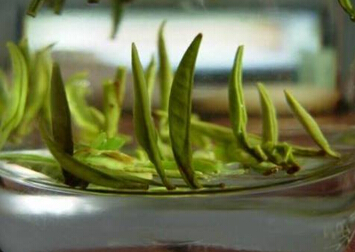Rhyme for identifying authentic Xinyang Maojian tea:
Choose one brewing method, remember to rinse first then steep;
One gram of tea leaves to fifty parts water, steep for three minutes before pouring;
Tea with leaves is more nutritious, one or two leaves are the best;
Single buds can be top-grade, but the soup must never be cloudy;
Eight common tea aromas, distinguish grassy from fresh fragrance;
Chestnut and floral aromas are superior, remember the seven tastes;
Sweet and mellow flavors are ideal, which of the five soup colors is best?
Clear with a hint of pale yellow in green, clear soup with mellow taste and high aroma;
Avoid cloudy, astringent, or grassy, keep these fourteen words in mind.
Evaluating tea quality and authenticity boils down to two points: rational evaluation and sensory evaluation. Rational evaluation mainly tests the tea's internal components, biochemical residues, moisture content, ash content, etc., to ensure it meets drinking standards. Sensory evaluation involves looking, smelling, tasting, and brewing, assessing the tea's dry appearance and wet inner qualities (aroma, soup color, taste, and leaf base) to determine its grade.

1. Look
Observe the shape, color, and soup color.
Shape: Any tea with overly tight, thin, or small leaves is not good;
Color: Any dry tea that is overly green is not good;
Soup color: Any cloudy soup is not good;
Explanation: To achieve the best balance of tea flavor and aroma, the frying process must be mastered. Frying involves dehydrating fresh leaves until they are dry and shaped. During frying, more tossing and less rolling are needed to allow heat to dissipate. Heat is essentially water, and better heat dissipation combined with the right temperature results in a more refreshing tea flavor and aroma. However, this may lead to a slightly looser and rougher appearance. Thus, high-quality tea may appear slightly looser and rougher.
Explanation: Overly green dry tea results from insufficient frying, where the tea retains too much grassy aroma. While the color may look appealing, the tea is not good.
Explanation: Overly small tea leaves can be categorized into four grades: thin and small (low quality), small buds (medium quality), tight and small (lower quality), and fine and small (poor quality).
Thin and small: Caused by undernourished fresh leaves, resulting in thin leaves and buds with weak flavor;
Small buds: Caused by harvesting single buds too early, resulting in small buds with little juice;
Tight and small: Caused by frying large-leaf tea before proper withering, combined with improper rolling, heat, and ventilation during frying. This results in a tight, small tea with astringency, slight cloudiness, grassy aroma, and bitterness, derogatorily called "big bland and cloudy";
Fine and small: Caused by frying single buds without proper withering, heat dissipation, rolling, and temperature control. This results in overly tight and fine tea with unripe tea juice stuck to the surface, which turns cloudy when brewed, with astringency, grassy aroma, and blandness, derogatorily called "small bland and cloudy".
Thus, regardless of leaf size or single buds, tea that is overly tight, fine, or small is not good.
Overly green soup, even if not cloudy, often has a grassy aroma and astringency, making it inferior. Green soup should be criticized, and cloudy soup should be rejected. Cloudy tea has misled consumers in our province for nearly two decades, making it hard to find good tea. Some tea merchants, tea art training classes, and so-called experts, lacking proper frying techniques, have spread misinformation such as "cloudy soup is a sign of Maojian," "no fuzz means it's not Maojian," or "cloudiness is from tea fuzz." These false claims have led Maojian tea astray.
Note: Small bud teas, though visually appealing, are often "small bland and cloudy," misleadingly marketed by some sellers—a regrettable practice.

2. Smell
Smell the aroma.
The dry tea should smell fragrant, the rinsed tea should smell fragrant, and the soup should smell fragrant. There should be no odd or grassy odors. Currently, many teas on the market have a grassy aroma, which some sellers misleadingly label as "fresh fragrance." Even if it is a fresh fragrance, it is still ordinary. Xinyang Maojian tea typically has eight aromas, with "floral" and "chestnut" being the best.
3. Taste
Taste the flavor.
Any astringent tea is not good, and any overly bitter tea is not the best. Due to the prevalence of astringent teas, some sellers misleadingly claim that "tea must be bitter and astringent." Astringency and bitterness, along with grassy aromas, are inherent to tea but should be transformed through proper frying into mellow, sweet flavors and mature aromas like chestnut, fresh, or floral. Xinyang Maojian can be slightly bitter but must never be astringent.

4. Brew
Proper brewing is also a test of tea quality. Tea that cannot withstand boiling water and a three-minute steep is not good. Good tea must endure boiling water and a three-minute steep—remaining non-astringent, non-bitter, non-cloudy, and non-grassy—to be considered good.
Currently, inferior teas are often brewed with lukewarm water and quick steeping to mask their flaws, as boiling water and a longer steep would reveal their astringency and bitterness. National tea evaluation standards require at least a three-minute steep. Tea is meant to be drunk for its juice, flavor, and aroma, which cannot be extracted without boiling water and sufficient steeping time. Tea is fried at 200°C without issue, so why fear 100°C boiling water? Tea is for drinking, not just looking at. Ancient tea was brewed by boiling, and some teas today are still prepared this way.
Thus, the claim that Maojian should be brewed with "lukewarm water, quick steeping, and fast pouring" is a cover-up for inferior tea. Reasons include: excessive moisture content that cannot withstand boiling water; insufficient frying leading to grassy aromas; or overly tight, fine leaves achieved by under-frying and over-rolling, which causes unripe tea juice to stick to the surface, resulting in astringency, cloudiness, and grassy aromas when brewed. In contrast, properly fried tea with the right moisture content requires boiling water and a three-minute steep to fully release its aroma and flavor.
Three Musts and Three Avoids
Good tea must meet three criteria and avoid three pitfalls:
Must have clear soup, high aroma, and mellow taste;
Avoid cloudy soup, astringency, and grassy aromas.
Visually, the soup should be clear—pleasing to the eye; olfactorily, it should have a pleasant aroma, not grassy or odd—pleasing to the nose; gustatorily, it should be refreshing, not astringent or odd—pleasing to the palate. No matter how the standards for famous teas like flat, curved, or needle-shaped teas change, they must not contradict these three musts and three avoids in terms of inner quality.